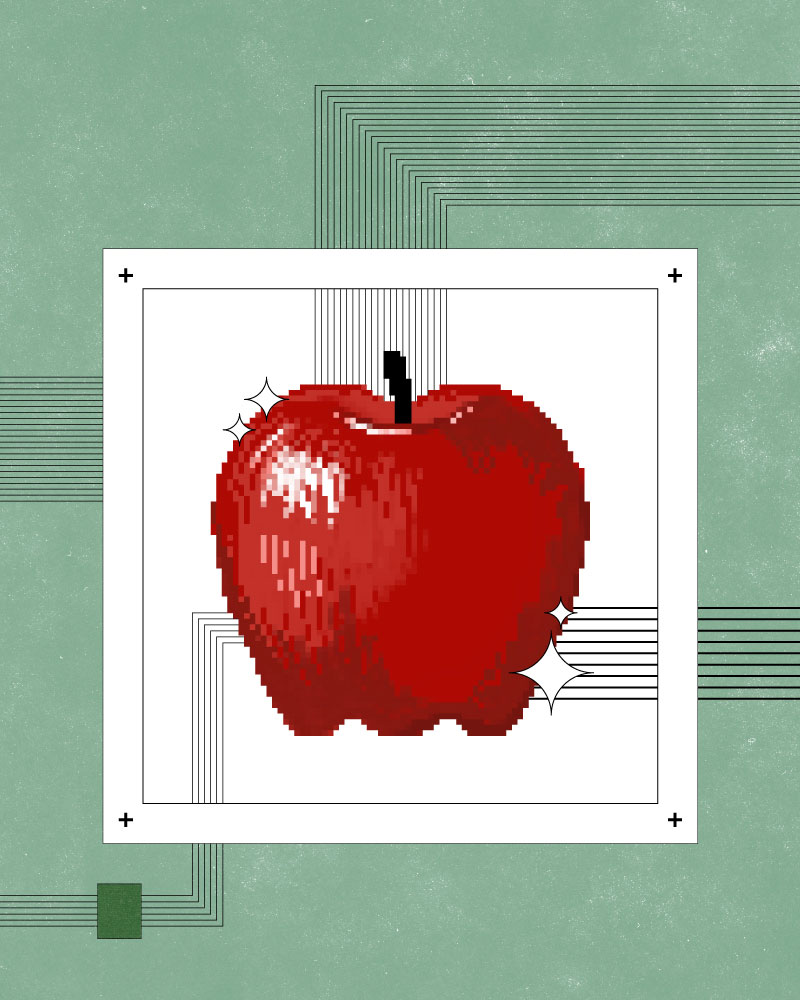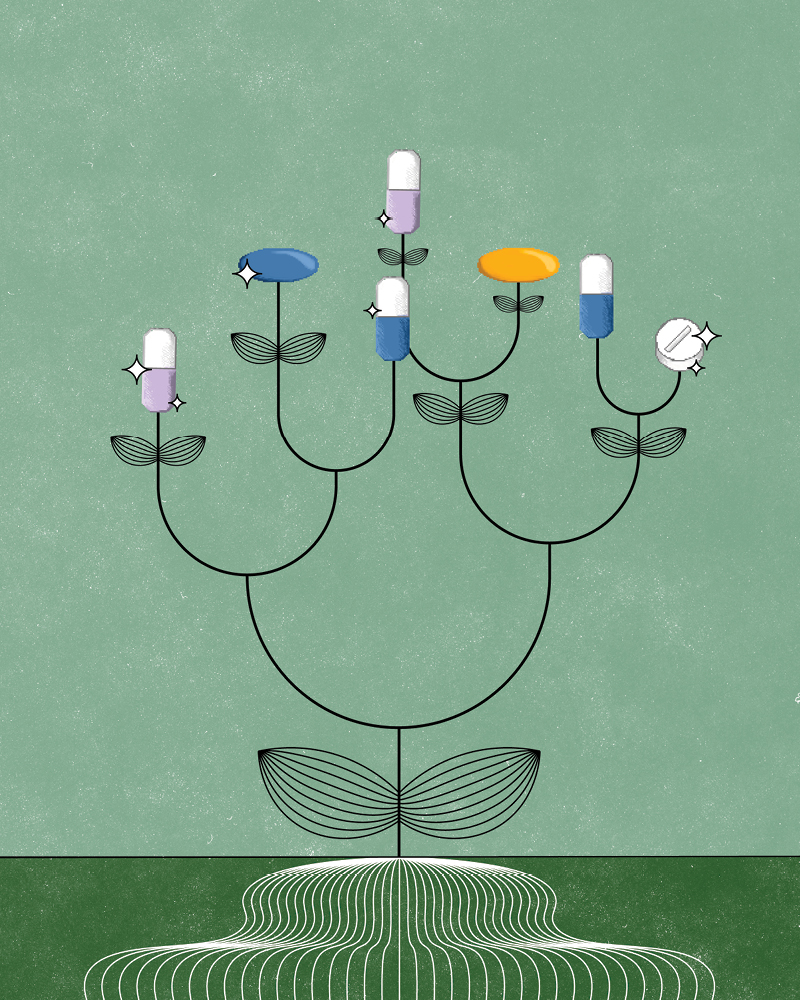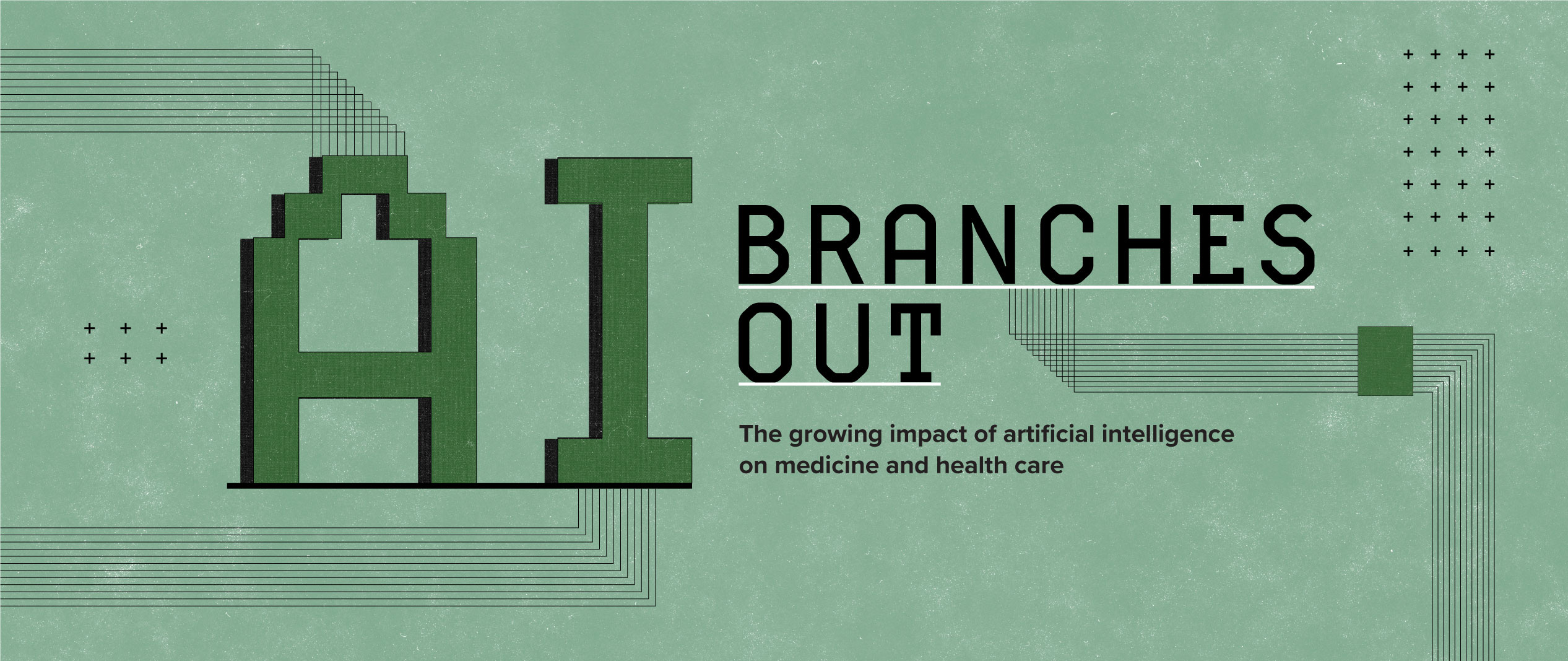In the early 1980s, a hit TV show introduced many Americans to artificial intelligence (AI). While Michael Knight, famously portrayed by David Hasselhoff, was technically the main character of “Knight Rider,” it was KITT, a black 1982 Pontiac Trans Am with the power to think and talk, that spurred fans of the show to tune in week after week. Forty years later, AI is causing changes in the medical field that would have read like science fiction not that long ago. In fact, experts at the Heersink School of Medicine do not hesitate to say that AI is in the process of revolutionizing the profession. “It’s hard to imagine an area of medicine that’s not going to be changed by AI,” declared Matt Might, Ph.D., director of the Hugh Kaul Precision Medicine Institute. “It’s going to redefine medicine on every level,” echoed Rubin Pillay, M.D., Ph.D., executive director of the Marnix E. Heersink Institute for Biomedical Innovation and Chief Innovation Officer for the UAB Health System. “It’s changing so fast that it’s hard to say where it’s going, except that it’s going to be everywhere,” said James Cimino, M.D., chair of the Department of Biomedical Informatics and Data Science. So what are the real-world consequences of using artificial intelligence in the medical field? Is Dr. Robot on the horizon? Here we take a look at some of the ways AI already is being used within UAB Medicine, and a glimpse at what may be on the horizon sooner rather than later.
Filling in the Blanks
It is a routine that has been taking place for generations. A patient tells a doctor what is wrong. The doctor asks questions, runs tests, makes a diagnosis, and recommends a treatment plan. If the first approach doesn’t succeed, they try again. Technology has already improved this type of trial-and-error exchange, and AI can improve it further, according to Cimino. He sees signs of how this can work through the use of generative AI like ChatGPT.

“Clinicians approach a patient’s problems starting with what they know and turn to knowledge resources as needed to fill information gaps. We used to build decision support systems that would try to anticipate the need for that information, but development was slow, expensive, and difficult to maintain,” Cimino said. “The emerging generative AI tools draw on an enormous set of information and can synthesize connections on the fly to bring better relevant knowledge to the point of care based on patient-specific data.
“I used to formulate questions about a patient, turn to various knowledge sources like text books, expert systems, or PubMed, and create a query to find what I thought might be relevant to the patient’s case. Now, I can put the patient’s information into something like ChatGPT and ask questions in plain English, let it retrieve relevant information from multiple sources, and integrate it all into a single (usually coherent) response.”
The immediate benefit is not only the ability to store all this medical data but also to distill it down to the most salient information, making it easier for patients and physicians to comprehend and communicate. “We have electronic health records that pull data from many different sources (such as clinicians’ notes, orders, and ancillary reports) into one place, but it is really difficult to navigate,” Cimino said. “If I put that whole record into generative AI and say, ‘Summarize this patient’s record for me,’ it will do it. Then patients can use this resource to help them understand their conditions.
“We also have what are called genomic-informed risk assessments, and they can be 25 pages long. I’m a physician and a researcher and even I have difficulty with them. I’ve taken those and asked ChatGPT to rewrite them for a person with a high-school education, and then again for a person with a sixth-grade education. It was simply amazing what it produced. This has tremendous potential.”
Taking it one step further, Cimino said he can foresee the day when there will always be a readily available second-opinion (and a third and fourth, if needed) in the form of AI. He said such a system could give a physician live advice as the initial patient-analysis process is taking place.
“There are a lot of things generative AI could eventually do if we can bring it to the point-of-care in an unobtrusive way,” Cimino said. “What if the computer can say to the doctor, ‘You should ask the patient this question.’ Physicians might find it annoying at first, sort of like a backseat driver, but once they realize that it can help them quickly diagnose something they might otherwise have missed, I think doctors and patients will appreciate it.
“Then we can give all this information to a generative AI system, and it can analyze it in the context of the patient’s care and say, ‘You need to pay attention to these genetic markers that this patient has.’ That is going to be a tremendous benefit.”
Cimino said these are just some of the many ways that AI technology can benefit medicine and makes physicians’ jobs easier. “It’s hard to imagine a problem we face in medicine that would not be made at least somewhat better with this,” Cimino said. “There are a lot of creative ways we can be using this at every point in the care process. Then along with better care, we have better data for research and discovery.
“Ultimately what we’re always trying to do is improve human health. And this new wave of artificial intelligence can help at every step of the way.”
AI in Medicine Master’s degree
In June 2024, UAB launched a Master of Science degree in Artificial Intelligence in Medicine (AIM), established collaboratively by the Heersink School of Medicine and the Marnix E. Heersink Institute for Biomedical Innovation (MHIBI). The new graduate degree program is the first of its kind in the Southeast and is designed to equip trainees with the specialized technical skills to manage large medical datasets for AI development.
“As part of graduate dissertation research, students will engage in cutting-edge research at UAB, collaborate with faculty experts, and utilize state-of-the-art AI labs across UAB to gain a comprehensive understanding of AI’s practical applications in medicine,” said Sandeep Bodduluri, Ph.D., director
of AI in the MHIBI and the M.S. degree in AIM program director.
The new degree program focuses on the development of sophisticated AI-driven applications for medical imaging and signal processing, as well as the creation of large language models to aid in clinical decision-making. The curriculum—developed in collaboration with the UAB Schools of Engineering, Business, and Health Professions and the College of Arts and Sciences—is structured to provide essential technical training for students who have completed the Graduate Certificate in AI in Medicine.
“At the Heersink School of Medicine and the Heersink Institute for Biomedical Innovation, we recognize the immense responsibility that preeminent academic institutions have in shaping the future of AI in health care,” said Rubin Pillay, M.D., Ph.D., MHIBI director. “Our AI programs are committed to training a diverse group of designers and developers
to create responsible, ethical solutions. We also empower users to make informed decisions about leveraging AI and ensure that individuals, whose data and care are managed by AI, can ask the right questions. Our suite of programming at MHIBI reflects our mission to democratize AI literacy and make
AI accessible and beneficial for all.”
– Alicia Rohan
Curated Biomedical Solutions
In many ways, Matt Might, Ph.D., was AI before AI was cool. He arrived at UAB in 2017 to lead the Hugh Kaul Precision Medicine Institute (PMI), which utilizes computative technologies such as genomic sequencing to personalize disease treatments.
“We’ve been using a form of AI since I got here to identify precision therapeutics,” Might said. “The thing that has changed is our ability to do it got a lot better very quickly. We’ve been helping patients for years by using this, but sometimes we’d hit a wall and we couldn’t go any further.
“Now we have a whole new way to creatively reason about ways to help patients that we didn’t have access to before. The kind of creative reasoning that AI can do to help patients is really remarkable. That’s one of the things that’s so powerful about this.”
As a recent example, Might said the PMI received an emergency outreach from the UAB Division of Infectious Diseases regarding a patient suffering from an extremely rare pathogen who was not responding to the only known treatment. Might’s team gathered all the available information, then began using AI systems to run case reviews in search of possible alternatives for care. The results surprised even Might.

From left to right: James Cimino, M.D., Matt Might, Ph.D.,
and Rubin Pillay, M.D., Ph.D.
“Within about an hour, we had five or six potential ideas—with scientific justification—for why these treatments might help this patient,” Might said. “We couldn’t have done that even a year ago. We just didn’t have the ability to deploy creative reasoning that quickly to come up with powerfully curated biomedical solutions.
“For us, a lot of this is not necessarily new because we’ve been using AI the whole time. But we’re definitely able to do it better now, there’s no question about that. And that has us revisiting precision diagnostics, because these newer generative AIs are really good at creative reasoning around potential diagnoses.”
Moving forward, Might said AI systems are proving to be extremely helpful in PMI’s work as part of the coordinating center for the national, NIH-funded Undiagnosed Diseases Network, which was established in 2014 to provide diagnostic assessments for patients with chronic, undiagnosed medical conditions.“We’re in contact with thousands of undiagnosed patients around the country who are on long diagnostic odysseys,” Might said.
“We’re using AI to summarize all the medical records and start making predictions around their diagnosis.” Humans were doing this previously, but it was an incredibly labor-intensive process, and it really limited how many patients we could help. Our goal now is to use AI to massively increase the scale of the number of patients we can help.”
Similarly, Might said AI will be able to alleviate issues that all physicians currently face in terms of daily administrative tasks that use up valuable time they could be spending trying to help patients. “You could have an AI listening in on a conversation between a physician and a patient, and then create a transcript that can be transformed almost automatically into any number of forms,” Might said. “This includes transforming it into code that can automatically draft any orders the physician mentioned during the consultation.
“Eventually we’re going to have intelligent surveillance of every engagement, every encounter, within the entire health system. I think AI will end up becoming a gigantic safety net around a health system to make sure that a patient doesn’t fall through the cracks.”
Even for a man whose career has long lived on the leading edge of technological advancements, Might said he is amazed at the sudden potential AI is unlocking within the medical field.
“This has been one of the strangest moments of my professional life,” Might said. “In computer science, we knew we would get here at some point. What has surprised even the computer scientists is how fast it has happened. It has emerged far sooner than anyone expected.”

Science Fiction come to life
Mistakes happen. Humans are fallible, after all. But Rubin Pillay, M.D., Ph.D., wants to see the number of mistakes that take place within the medical field drastically reduced. And he says the solution will be to not rely solely on humans.
“If you look at health care delivery globally, our diagnostic and therapeutic error rate is about 12 percent and preventable deaths are around 400,000 cases a year in the U.S. alone,” Pillay said. “It’s a problem that needs to be addressed, and AI and medical automation is going to help us get there, like it has in many other industries. Automation has essentially democratized access to most products and services, and it will do the same in health care.
“We’re not far off from a time where we’ll be questioned if we’re using solely human capacity and capability to deliver care. Probably within the next five years, most physicians will augment themselves with AI, and it’s something that we need to do.”
In fact, Pillay said the medical profession is in the early stages of being entirely transformed by AI. When asked what areas of the field will be affected by this technology, he quickly replies, “Pretty much everything.”
“The immediate impact is on the operations and administrative side, which is a huge burden,” Pillay said. “One of the leading causes of physician burnout is the administrative functions that they perform, and technology is rapidly improving that. It’s going to allow physicians to spend more quality time with patients, which will result in better care and better patient outcomes.
“On the clinical side, we’re still a little bit away from AI having a tangible impact on care delivery.” However, Pillay said that will soon change, and eventually AI will supplement or in some cases replace medical work currently being performed by humans. “There are already AI solutions out there to read radiological images; you upload your image and the AI does the interpretation for you. At the moment, a lot of this is just being used for screening to validate clinical decisions, but we’ve started that process.”
As a result, Pillay said it is crucial for UAB and other medical schools to begin changing the way they train future physicians to accommodate for AI. After all, by the time today’s incoming students complete four years of medical school followed by a residency, it will be the 2030s and many of today’s AI concepts will have become reality.
“The practice of medicine is going to change dramatically, and we’re going to need a revolution in medical training,” Pillay said. “AI is ultimately going to lead to better care delivery, because physicians will be able to use all the available knowledge and data to make clinical decisions, which is humanly impossible to do.
“Eventually the next big leap will be medical automation. There is the potential to replace physicians in certain aspects of care delivery. It’s going to be a leap of faith for both patients and physicians, but it is inevitable.”
After a pause, Pillay added, “It’s science fiction come to life.”
-Cary Estes
Sparking drug discovery
Technological advances such as gene editing, cancer immunotherapy, click chemistry, RNA therapeutics, and cell-based therapy have sparked a growing interest in new approaches to drug discovery. The new Systems Pharmacology Artificial Intelligence Research Center (SPARC)—a partnership between the Heersink School of Medicine and the UAB Center for Clinical and Translational Sciences (CCTS)—is focused on developing new AI-based approaches in disease biology modeling, in silico drug design, and human clinical trials to accelerate drug discoveries while reducing costs. The center is led by Jake Chen, Ph.D., the Triton Endowed Professor of Biomedical Informatics and Data Science.
“Drug discovery has become too costly and too complex for any lab scientist to lead today,” said Chen. “We aim to build critical technology infrastructure fueled by the rapid growth of AI, multi-modality disease biology data, and high-performance computing.”
As a transdisciplinary research center, SPARC will drive innovation in systems biology—the integration of multi-omics data of disease biology—and generative AI to accelerate identification and development of new drugs based on deep understanding of causal human biology and real-world clinical needs.
“The placement of SPARC within our department is timely and appropriate,” said James Cimino, M.D., chair of the Department of the Biomedical Informatics and Data Science. “SPARC researchers will expand the department’s domain of inquiry, while recruitment of new faculty to the department will complement SPARC research by providing a breadth of expertise in areas such as clinical informatics, implementation science, and evaluation.”
“SPARC will build new avenues to cost-effective drug development matched with the emerging AI revolution,” said Chen. “We look forward to building partnerships in an exciting, decentralized drug discovery ecosystem in the years to come.”
– Ryan McCain
